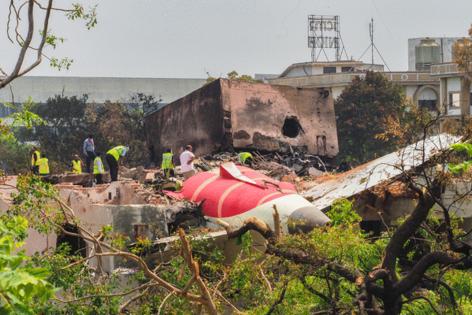Air India crash: As focus shifts to pilot, suspicion outpaces answers
Published in News & Features
SEATTLE — With conclusive information hard to come by five weeks after the fatal Air India crash, the aviation industry has shifted its focus to the possibility of pilot error.
It’s too soon to know what brought down a Boeing 787 plane moments after takeoff from Ahmedabad, India, on June 12. It could be months before investigators from India’s Aircraft Accident Investigation Bureau release the final report with a probable cause, and that report may not settle the issue.
But after a preliminary report published last week, aviation safety experts have started to consider whether the crash was the result of human action.
The preliminary report from Indian aviation authorities indicated one of the pilots cut power to both engines by moving two switches that control the flow of fuel. The switches moved from the “run” to “cutoff” position seconds after takeoff, with just one second between the two movements, the report said.
Some conclusions can be drawn from that cursory information, according to former accident investigators and aviation safety consultants who spoke with The Seattle Times this week. But why one of the pilots would have moved the switches isn't among the questions it can answer — and is the biggest focus for the rest of the investigation.
At this stage, the preliminary report points to pilot error, in part because the report lowers the likelihood of other scenarios, said Mike Dunlop, an aviation expert, author and founder of supply management software company Net-Inspect.
“From a mechanical, software, electronic standpoint, I cannot think of any possible combination of events that could cause what happened when it happened,” Dunlop said.
“The simplest explanation is almost always the one that happened,” he said. Any other theories would require “too many coincidences.”
Still, other experts say it's premature to rule out other causes, including manufacturing, electrical or maintenance errors that may have led both engines to lose power or influenced the pilots' behavior.
Speculation about intentional acts by one of the pilots has been met with criticism from unions and advocacy groups representing pilots in India, as well as India’s Aircraft Accident Investigation Bureau and the U.S. National Transportation Safety Board, which is helping with the investigation.
The Air Line Pilots Association, a global union, doesn’t comment on active investigations but said in a statement, “it’s vital that all factors are thoroughly and exhaustively evaluated. … Engaging in speculation only serves to hamper and undermine the ongoing investigation.”
Early theories
The preliminary report did rule out a few possible causes, including that the crash was the result of fuel contamination or that the flaps and slats on the airplane’s wings were incorrectly positioned.
The report also noted the lowered position of the landing gear, another early hypothesis, was consistent with the two engines losing power.
In the flight’s final seconds, the cockpit voice recorder captured one pilot asking the other why they had moved the engine fuel control switches, effectively cutting power to both engines, according to the preliminary report. The other pilot responded that they had not done so.
The preliminary report did not specify which pilot was talking when, so it’s not clear who moved the switches. First Officer Clive Kunder was flying the plane, while Capt. Sumeet Sabharwal, the more senior pilot, was monitoring.
Media reports this week said it was likely the captain who moved the switches, with the first officer asking why he had done so.
The reports cited anonymous sources, drawing complaints from accident investigators and organizations representing pilots.
NTSB Chair Jennifer Homendy said Friday that “recent media reports … are premature and speculative.”
The Federation of Indian Pilots pointed some of the blame back to accident investigators, writing in a Wednesday letter that the preliminary report “appears to rely selectively on paraphrased cockpit voice recordings to suggest pilot error and question the professional competence and integrity of the flight crew.
“Assigning blame before a thorough, transparent and data-driven investigation is both premature and irresponsible,” the advocacy group continued.
Complete inspections
To flip the engine fuel control switches, positioned between two metal guards near the aircraft throttles between the cockpit seats, pilots must make two movements — a pull up and over. That makes it difficult to accidentally move them, the aviation experts said.
The preliminary report resurfaced a 2018 bulletin from the Federal Aviation Administration following reports that the mechanism on some 737s had been installed with the locking feature disengaged.
The bulletin recommended inspections for other models with similar fuel control switches, including the 787.
Air India did not perform the inspections because they were recommended, not required, according to the preliminary report. But it did replace the throttle control module, which includes the switches, on the Everett-built plane in 2019 and 2023, for reasons unrelated to the switches.
After the preliminary report’s release, India and South Korea ordered airlines to inspect engine fuel control switches on their 787 fleets.
Air India said Wednesday it had completed the inspections and did not find any problems, according to The Times of India.
Conclusive findings
Even without the recent media reports, some former accident investigators said the preliminary report included enough information to determine the crash was the result of pilot action.
Investigators “didn’t tell us everything,” said John Nance, a former pilot, aviation safety analyst and author. “But what they did say, conclusively, says not only did a human being cut off the two fuel control switches one at a time, but the facts as presented preclude any other explanation.”
Nance ruled out the possibility of a mechanical or electrical error because the two switches flipped about one second apart. If there had been some sort of system failure, he would expect them to flip simultaneously.
Dunlop similarly said the one-second difference pointed toward intentional pilot action.
One of the pilots later flipped the switches back to the "run" position, and the engines began to relight but did not have enough time or altitude to fully restart before the plane crashed. The fact that the engines started cycling again, Dunlop said, indicates the systems were working properly.
A commercial pilot would know that cutting power to both engines at that stage of the flight was almost guaranteed to be catastrophic, Dunlop said.
The first five to 10 seconds and 500 to 600 feet of climb are the “most vulnerable” for any flight, he said.
Dunlop said the flight data recorders could provide more evidence to rule out the possibility of a software, mechanical or electronic issue. Because the switches make a clicking sound when manually moved, the recorder could have captured the movement.
To listen for that sound, investigators have to strip out all the other noise collected by the flight data recorders, said Dunlop. That leaves them with just the background noise.
Then, investigators would record the click of the fuel engine switches moving on another plane and try to match that sound to anything they hear in the cockpit voice recorder from the fatal flight.
'A hard thing to answer'
Investigators will now scour the pilots’ medical histories, said Jeff Guzzetti, a former accident investigator with the FAA and NTSB.
That means talking with the pilots’ families, friends and associates, as well as anyone who spoke with them before the fatal flight, to get a sense of their moods. Investigators will also speak with the physicians who cleared the pilots to fly, consider any medications they were taking and determine if there were any life events that may have altered their mental states.
Historically, in cases where a plane crash was the result of an intentional act by the pilot, there have been “clear signs,” Guzzetti said. In this case, it's too soon to have identified those signs and, Guzzetti said, it's too soon to know if the action was intentional or not.
“I know the easiest, most plausible theory is an intentional act to crash the airplane, but I just think it’s way too early,” Guzzetti said. “I think there needs to be a lot of thought behind why they would have moved those switches.”
He wasn’t surprised that investigators didn’t identify which pilot was speaking in the preliminary report. That’s either because they’re not entirely sure or because they are hesitant to indict someone at this stage of the investigation.
“It’s hard for people in aviation to wrap their minds around an intentional act,” Guzzetti said. “Why would a pilot ever want to do this? It’s a hard thing to answer.”
© 2025 The Seattle Times. Visit www.seattletimes.com. Distributed by Tribune Content Agency, LLC.







Comments